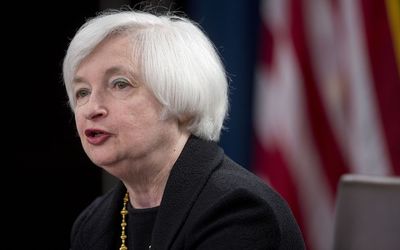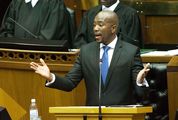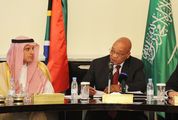STRIKING the appropriate tone is tough enough for our monetary policy makers, so spare some sympathy for how much harder is it for US Federal Reserve (Fed) chairwoman Janet Yellen. She has the world dissecting her every word, every time she speaks officially in public.
Her comments on US interest rates made on the first day of testimony before legislators this week should have been good for emerging-market and other more risky assets. But after an initial rally in stocks and currencies, her warnings about the outlook for US growth sparked a widespread sell-off, plunging markets into the red on Thursday.
As the Guardian newspaper put it: "There wasn’t much Yellen could say that wouldn’t have spooked the markets."
Ms Yellen reiterated that rates would be raised gradually. So apparently there’s no appetite at the Fed for negative interest rates such as at the European, Swiss or, most recently, the Japanese central banks. Nor is the Fed about to retreat from the interest rate hike it implemented in December.
Yet Ms Yellen did make it clear that the next interest rate hike won’t be anytime soon. That has had economists who had pencilled in a March increase, with more to follow, reaching for their models again.
The comments saw a jump in emerging-market currencies and a rally in bonds. The rand, which has been topping lists of the worst performers, led gains. Though the prospect of a much-slower-than-expected US rate-hiking cycle could support emerging-market currencies and reduce the recent intense volatility, it’s not clear that the boost is anything more than a temporary fillip.
There’s also the possibility that the surge was prompted more by dollar weakness than emerging-market currency strength.
Nor is it clear yet that the relentless capital outflows that emerging markets have seen over the past seven months has stabilised, even though there have been some tentative signs of a turn.
The trouble is the paradoxical relationship between US growth and US interest rates, and how that plays out in the rest of the world — along with how global factors affect the US.
The prospect of US rate hikes has been one of the major causes of volatility and outflows from emerging markets over the past couple of years. There were concerns that higher US rates would take away the yield advantage that emerging-market assets, though deemed more risky, have enjoyed since the global financial crisis.
But higher interest rates are also an indication of stronger growth prospects in the world’s largest economy.
The US’s fortunes still determine those of the rest of the world — hence the gloom in response to Ms Yellen’s comments that financial conditions had become "less supportive" of US’s growth, and that higher risks from China could also dent the US’ progress. That negative feedback loop from the developing world, particularly China, to the developed world is the big shift of recent years.
Ms Yellen singled out China as a central risk factor. And whereas the tone of her last public statement in December had been upbeat, this week’s was far more wary, with its emphasis on global risks and the dampening of global growth hopes.
This is not good for emerging markets. The developing world is having to come to terms with a "new normal" in terms of growth rates that are barely more than half of their pre-financial crisis peak. One potential bright spot is a possible recovery in oil prices, which some expect could pick up, perhaps to the $50-$55 a barrel range, later this year as the market moves into balance. That would be good news for the oil exporters, — but very bad for SA.
The lesson is that we can’t look to the global economy to drag us out of a slump. We will have to do so by ourselves.

US Federal Reserve chairwoman Janet Yellen. Picture: BLOOMBERG/ANDREW HARRER
STRIKING the appropriate tone is tough enough for our monetary policy makers, so spare some sympathy for how much harder is it for US Federal Reserve (Fed) chairwoman Janet Yellen. She has the world dissecting her every word, every time she speaks officially in public.
Her comments on US interest rates made on the first day of testimony before legislators this week should have been good for emerging-market and other more risky assets. But after an initial rally in stocks and currencies, her warnings about the outlook for US growth sparked a widespread sell-off, plunging markets into the red on Thursday.
As the Guardian newspaper put it: "There wasn’t much Yellen could say that wouldn’t have spooked the markets."
Ms Yellen reiterated that rates would be raised gradually. So apparently there’s no appetite at the Fed for negative interest rates such as at the European, Swiss or, most recently, the Japanese central banks. Nor is the Fed about to retreat from the interest rate hike it implemented in December.
Yet Ms Yellen did make it clear that the next interest rate hike won’t be anytime soon. That has had economists who had pencilled in a March increase, with more to follow, reaching for their models again.
The comments saw a jump in emerging-market currencies and a rally in bonds. The rand, which has been topping lists of the worst performers, led gains. Though the prospect of a much-slower-than-expected US rate-hiking cycle could support emerging-market currencies and reduce the recent intense volatility, it’s not clear that the boost is anything more than a temporary fillip.
There’s also the possibility that the surge was prompted more by dollar weakness than emerging-market currency strength.
Nor is it clear yet that the relentless capital outflows that emerging markets have seen over the past seven months has stabilised, even though there have been some tentative signs of a turn.
The trouble is the paradoxical relationship between US growth and US interest rates, and how that plays out in the rest of the world — along with how global factors affect the US.
The prospect of US rate hikes has been one of the major causes of volatility and outflows from emerging markets over the past couple of years. There were concerns that higher US rates would take away the yield advantage that emerging-market assets, though deemed more risky, have enjoyed since the global financial crisis.
But higher interest rates are also an indication of stronger growth prospects in the world’s largest economy.
The US’s fortunes still determine those of the rest of the world — hence the gloom in response to Ms Yellen’s comments that financial conditions had become "less supportive" of US’s growth, and that higher risks from China could also dent the US’ progress. That negative feedback loop from the developing world, particularly China, to the developed world is the big shift of recent years.
Ms Yellen singled out China as a central risk factor. And whereas the tone of her last public statement in December had been upbeat, this week’s was far more wary, with its emphasis on global risks and the dampening of global growth hopes.
This is not good for emerging markets. The developing world is having to come to terms with a "new normal" in terms of growth rates that are barely more than half of their pre-financial crisis peak. One potential bright spot is a possible recovery in oil prices, which some expect could pick up, perhaps to the $50-$55 a barrel range, later this year as the market moves into balance. That would be good news for the oil exporters, — but very bad for SA.
The lesson is that we can’t look to the global economy to drag us out of a slump. We will have to do so by ourselves.




















Change: -0.47%
Change: -0.57%
Change: -1.76%
Change: -0.34%
Change: 0.02%
Data supplied by Profile Data
Change: -1.49%
Change: -0.01%
Change: -0.47%
Change: 0.00%
Change: -0.08%
Data supplied by Profile Data
Change: 0.61%
Change: 0.85%
Change: 0.20%
Change: -0.22%
Change: 0.93%
Data supplied by Profile Data
Change: 0.29%
Change: -0.32%
Change: 0.13%
Change: -1.40%
Change: -1.88%
Data supplied by Profile Data